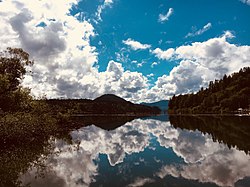Cowichan Valley Regional District
Cowichan Valley | |
|---|---|
| Cowichan Valley Regional District | |
 | |
 Location in British Columbia | |
| Country | Canada |
| Province | British Columbia |
| Seat | Duncan |
| Government | |
| • Type | Regional district |
| • Body | Board of directors |
| • Chair | Ian Morrison (F) |
| • Vice chair | Sierra Acton (B) |
| • Electoral areas |
|
| Area | |
| • Land | 3,474.52 km2 (1,341.52 sq mi) |
| Population (2016)[2] | |
• Total | 83,739 |
| • Density | 24.1/km2 (62/sq mi) |
| Website | cvrd.bc.ca |
The Cowichan Valley Regional District is a regional district in the Canadian province of British Columbia is on the southern part of Vancouver Island, bordered by the Nanaimo and Alberni-Clayoquot Regional Districts to the north and northwest, and by the Capital Regional District to the south and east. As of the 2011 Census, the Regional District had a population of 80,332. The regional district offices are in Duncan.
Geography
The Cowichan Valley Regional District covers an area between the Stuart Channel and Saanich Inlet on the east coast of Vancouver Island and the southern part of the West Coast Trail, with Cowichan Lake and Cowichan Valley proper located in its central region. It includes the Gulf Islands of Thetis, Kuper and Valdes. The total land area is 3,473.12 km² (1,340.98 sq mi).
Communities
Incorporated communities
- City of Duncan - Pop 4,944
- Town of Ladysmith - Pop 8,537
- Town of Lake Cowichan - Pop 3,226
- District Municipality of North Cowichan - Pop 29,676
Indigenous Reserves
- Chemainus 13
- Claoose 4
- Cowichan 1
- Cowichan 9
- Cowichan Lake
- Est-Patrolas 4
- Halalt 2
- Kil-pah-las 3
- Kuper Island 7
- Lyacksun 3
- Malachan 11
- Malahat 11
- Oyster Bay 12
- Portier Pass 5
- Shingle Point 4
- Squaw-hay-one 11
- Theik 2
- Tsussie 6
- Wyah 3
Electoral areas
A
B
C
D
E
F
G
H
I
References
- ^ "Board of Directors". Retrieved July 9, 2019.
- ^ a b "Population and dwelling counts, for Canada, provinces and territories, and census divisions, 2016 and 2011 censuses – 100% data (British Columbia)". Statistics Canada. February 8, 2017. Retrieved July 9, 2019.
External links
- Cowichan Valley Regional District
- Imagine the Cowichan, Simon Fraser University's Imagine BC series
- "Cowichan Valley Regional District". BC Geographical Names.
